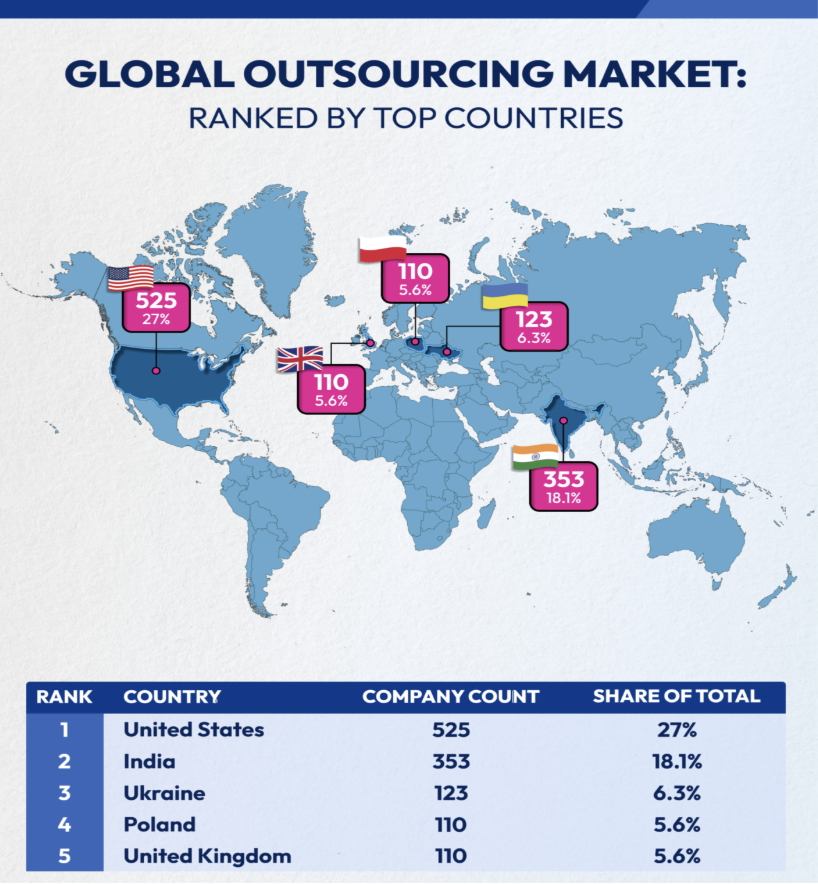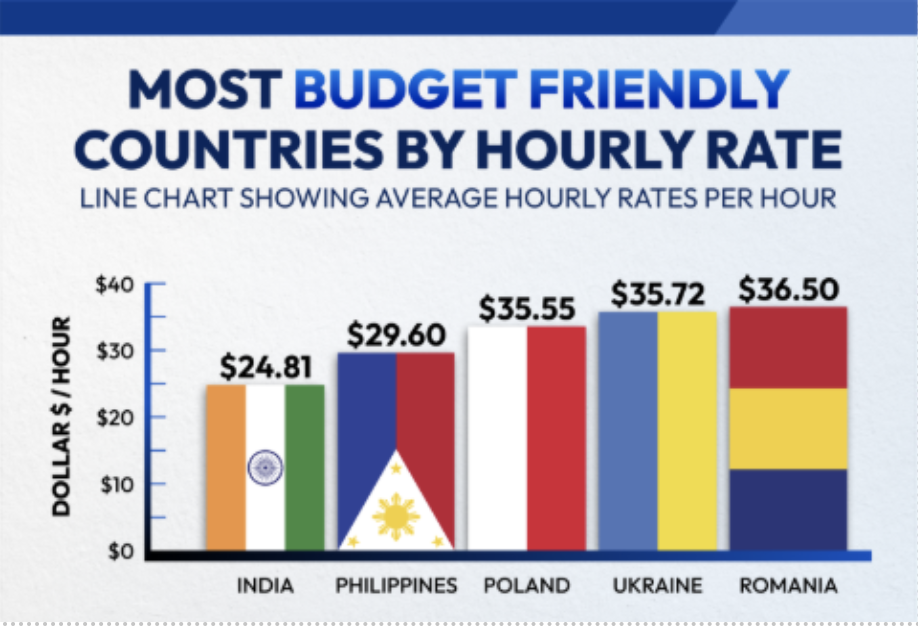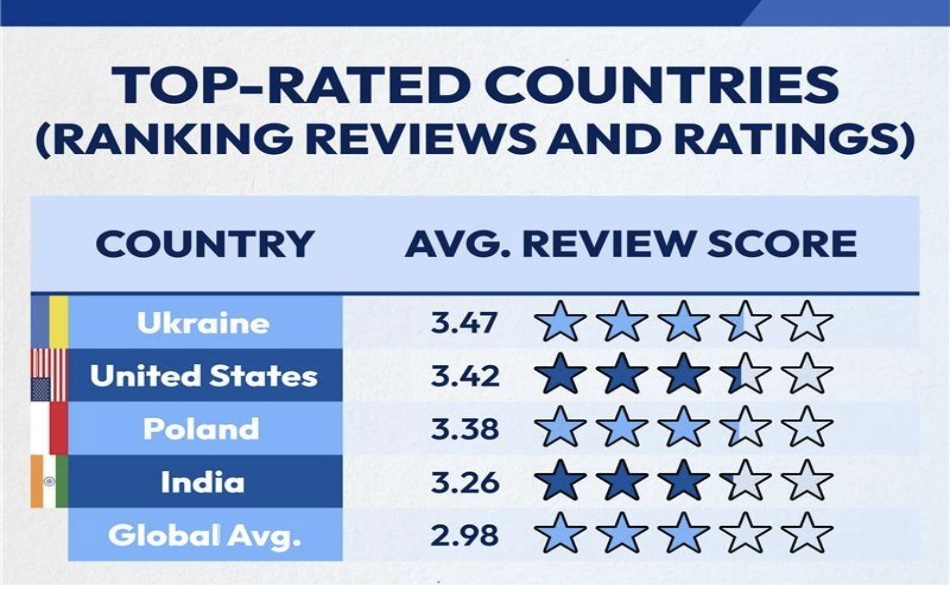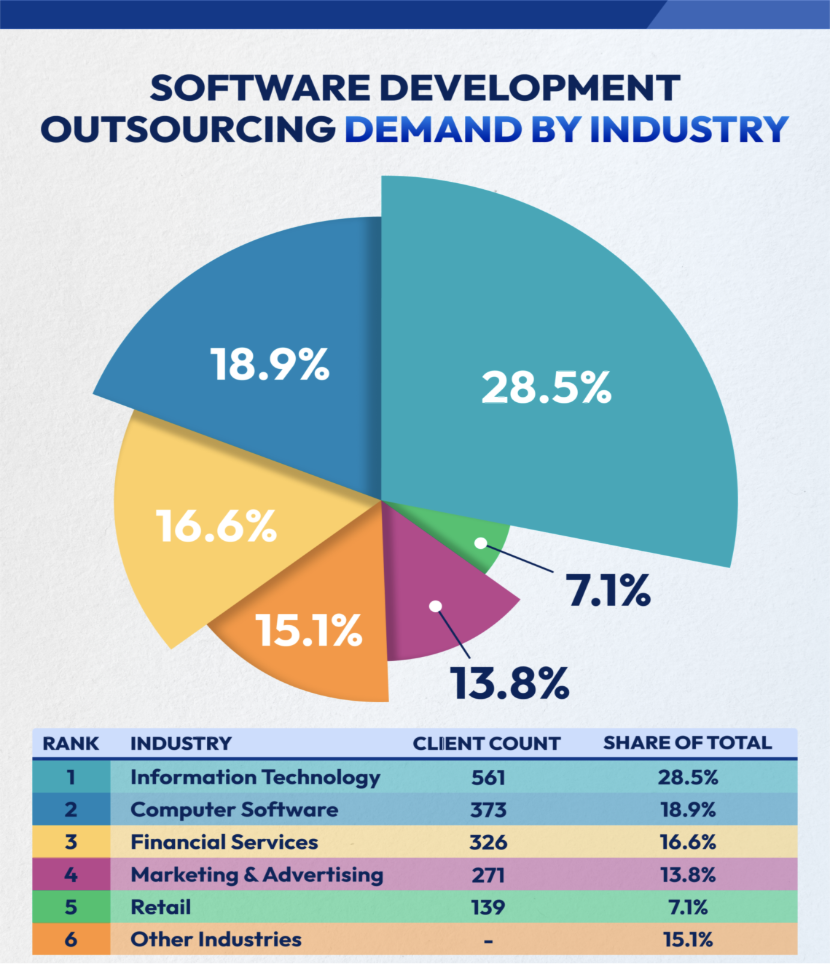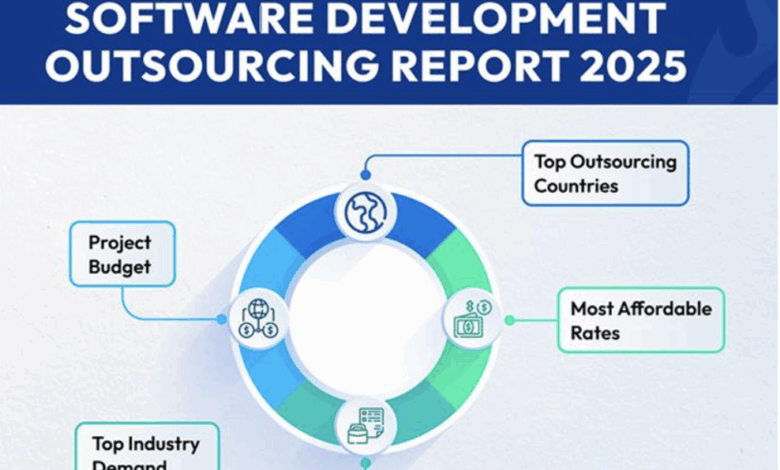
Software development outsourcing is no longer just about saving money. In 2025, it has become a more flexible option for companies of all sizes, including those with limited budgets and lean technical teams.
Recent analysis from DesignRush, based on over 2,000 companies across 80 countries, reveals that while the United States still leads in scale and workforce, other regions are offering increasingly competitive alternatives.
The data also highlights how cost, location, and client experience give companies more to consider when choosing development partners.
U.S. Market Still Leads in Size and Volume
The United States still holds the top position in the global software development outsourcing market.
It accounts for 27 percent of total firms and 34 percent of the global workforce in this category. More than 525 U.S.-based companies participated in the analysis, with a combined 68,775 employees.
On average, these firms charge $49.83 per hour and support project budgets averaging $31,167. That is roughly 50 percent higher than the global average budget of $21,380.
Despite the cost, U.S. providers continue to receive high satisfaction scores. Their ability to support multiple projects at once and maintain consistent delivery times makes them a dependable choice for companies with larger or more complex needs.
Pricing Across U.S. States Still Varies Widely
Not every U.S. state follows the national pricing trend.
Maryland is currently the most affordable region for software development outsourcing, with an average rate of $15 per hour. New Jersey, Massachusetts, and Tennessee also fall well below the national average.
On the higher end, Oregon tops the list at $102 per hour. Pennsylvania and Michigan follow closely behind. These rates are often associated with firms that specialize in niche industries or have highly specific technical skills.
For companies that want to work with U.S.-based teams but need to stay within budget, looking at smaller or less competitive markets may provide more options.
Lower Costs Without a Drop in Service
On the global scale, pricing varies widely, but lower rates no longer suggest poor outcomes.
A quarter of firms in the dataset charge under $20 per hour. More than a third charge under $35. These price ranges are common in India, the Philippines, Poland, and parts of Eastern Europe.
India has the lowest average rate at $24.81 per hour. Even countries like Ukraine and Romania fall below $40.
Despite these low rates, many of these companies show solid client satisfaction scores. That combination of affordable pricing with consistent delivery is now common in several of the top-performing markets.
The report also shows that firms with higher rates tend to be concentrated in the United States and Western Europe. But clients are no longer limited to these markets if they want experienced teams.
Satisfaction Scores Are Improving in Key Markets
Service quality is often difficult to compare, but client satisfaction scores offer a useful signal.
Ukraine currently holds the highest average review score at 3.47 out of 5. The United States follows at 3.42. Both are significantly higher than the global average of 2.98.
What stands out about these countries is that their providers serve a wide range of clients across industries. In the United States, the average number of clients per company is 4.38. That is more than twice the global average of 1.69.
This level of volume suggests these providers are not only handling more work but also meeting expectations consistently.
Demand Is Still Highest in Tech, Finance and Marketing
Companies across many industries use software development outsourcing, but a few sectors continue to lead.
IT services account for 28.5 percent of client demand. Software outsourcing companies represent 18.9 percent. Together, these two categories make up nearly half of all projects.
Financial services is the third largest client group at 16.6 percent. These firms often require secure systems and regulatory compliance, which has driven demand for external partners with domain knowledge.
Marketing and retail also appear in the top five, with increasing interest in front-end development, mobile applications, and eCommerce builds.
This concentration of demand in fast-paced, product-driven industries explains why providers are focusing on speed, scalability, and flexibility.
More Firms Are Taking on Smaller Projects
One of the biggest changes this year is that software development outsourcing firms are welcoming smaller projects.
According to the report, 42% of global providers now accept contracts under $10,000. In India, that number is even higher. More than half of the companies based there take on work at this level.
A subset of Indian firms goes even further. There are 46 firms accepting projects starting at $1,000 or less. These are not limited to freelancers or newly formed agencies; many have established track records and consistent review scores.
Countries like Canada and Australia are also showing unexpected flexibility. Over 60 percent of providers in these regions accept smaller budgets, which stands out given their higher labor costs.
For startups or internal teams that need to deliver quickly without making long-term hires, these options make software development outsourcing far more accessible.
What Companies Should Watch When Choosing a Provider
Software development outsourcing in 2025 is easier to access, but choosing the right provider still depends on the project.
Teams should consider:
- Whether their budget fits the market averages
- If the provider has experience with similar project scopes
- Review scores and how they compare to regional benchmarks
- The average number of clients handled per firm
- Hourly rates in both local and international markets
There is no single best country or pricing tier. A provider in India with strong reviews may deliver better results than a higher-priced team in Western Europe. A firm in Maryland may offer the same code quality as one based in California, for a fraction of the rate.
Final Thoughts
In 2025, software development outsourcing is more balanced than ever. Project minimums are lower, rates are more flexible, and satisfaction is rising.
This combination makes it a stronger option not just for established tech companies, but also for early-stage businesses and internal teams under pressure to deliver.
Choosing a provider still takes careful research. But the availability of affordable, well-reviewed teams in markets around the world means companies now have more control over who they hire and how they spend.

